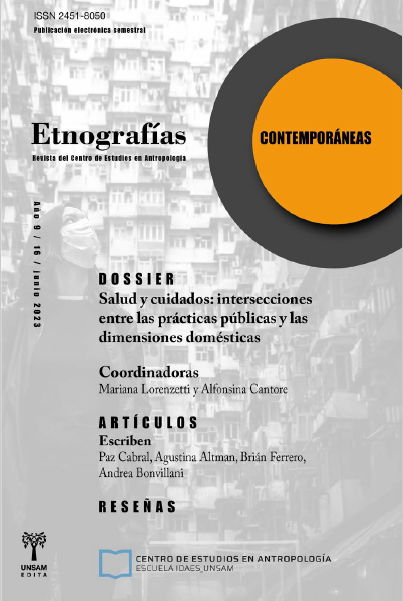“Leave the body at home.”
Digital ethnography of an anti-repression protest in times of COVID-19
Keywords:
protest, pandemic, digital ethnography, social networks, cyberactivismAbstract
This article aims to describe the incidence of the social isolation health measure derived from the COVID-19 pandemic in a mobilization against the public security policies of the Government of the Province of Cordoba (Argentina). This mobilization has been carried out through the streets of the city of the same name for more than a decade. The methodological strategy consisted of a digital ethnography based on three observation scenarios (virtual assembly, social networks and live broadcast on YouTube) and three interviews with activists, using technological media. In the universe of meaning of these activists, the excluding space of struggle is the street, thus protest on public roads is a defining characteristic of collective action. The virtual modality is defined as “necessary” for adherents affected by the health crisis, but it does not replace collective action in the street and is far from being considered a cyberactivist strategy. Ethnographic tools allowed me reconstruct the experience lived by the researcher in the live broadcast of the protest action, identifying a complex of sensations linked to the absence of physical co-presence that the technologically mediated communication cannot overcome: disconnection between the virtual world and the real, passivity, alienation and loneliness.
References
Alonso, Rocío (2017). Cibermilitancia y Subjetividad(es) Política(s): Una aproximación a la Marcha de la Gorra desde la Etnografía Virtual (Tesis de grado sin publicar). Facultad de Psicologia, Universidad Nacional de Cordoba, Cordoba.
Beaulieu, Anne (2010). “Research Note: From Co-location to Co-presence: Shifts in the Use of Ethnography for the Study of Knowledge”, Social Studies of Science, Vol. 40, N° 3, pp. 453–70. https://doi:10.1177/0306312709359219
Benítez Larghi, Sebastián (2016). “Desigualdades sociales y digitales: tras los rastros de la apropiacion tecnologica entre jovenes estudiantes secundarios de Argentina”, Controversias y concurrencias latinoamericanas, Vol. 8, N°13, pp. 68-79.
Bonvillani, Andrea (2015). “El Codigo de Faltas de la provincia de Cordoba (Argentina) como dispositivo de poder. La construccion de la seguridad a partir de la equivalencia simbolica “joven pobre=peligroso””, Revista Controversias y Concurrencias Latinoamericanas, Vol. 7, N° 11, pp. 81-101. http://ojs.sociologia-alas.org/index.php/CyC/issue/view/12/CyCL%20Vol7%20N11%20%5B2015%5D
––– (2016). “Habitar la Marcha: notas etnograficas sobre una experiencia de protesta juvenil”, Universitas Psychologica, Vol. 14, N° 5, pp. 1599-1612. DOI: http://dx.doi.org/10.11144/Javeriana.upsy14-5.hmne
––– (2018a). “Etnografia Colectiva de Eventos: La Cronotopia Paradojal de la Marcha De La Gorra (Cordoba, Argentina)”, De Prácticas y Discursos, Ano 7, N° 9, pp. 161-184. https://ppct.caicyt.gov.ar/index.php/depracticasydiscursos/article/view/13050
––– (2018b). Entre el folclore de la fiesta y lo irreparable de la muerte juvenil: la experiencia de la Marcha de la Gorra. Buenos Aires, Grupo Editor Universitario.
––– (2019a). “Negros de alma. Imaginarios racializados y juvenicidio en la Cordoba de las campanas”. Tabula Rasa, N° 31, pp. 325-346. DOI: https://doi.org/10.25058/20112742.
––– (2019b). “Vicisitudes de la construccion de la identidad colectiva en una experiencia de movilizacion juvenil en Cordoba (Argentina)”, Prácticas de oficio, Vol. 2, N° 22, pp. 124-134.
––– (2020). “Verdugueo: sentidos subjetivos acerca del hostigamiento policial que sufren jovenes de sectores populares de Cordoba (Argentina)”. Polis, N° 55, pp. 24-39. http://dx.doi.org/10.32735/s0718-6568/2020-n55-1442.
Bonvillani, Andrea y Roldán, Macarena (2017). “Politizacion de los cuerpos juveniles: la Marcha de la Gorra como performance multitudinaria”, Aposta, N° 74, pp. 165-203. http://apostadigital.com/revistav3/hemeroteca/bonvillani.pdf.
Burgos, Edixela (2020). Ciberactivismo, ejercicio de la ciudadanía y participación política en Internet. Venezuela, Universidad Catolica Andres Bello.
Cefaï, Daniel (2008). “Los marcos de la accion colectiva. Definiciones y Problemas”, en: Natalucci, Ana (edit.): Sujetos, movimientos y memorias. Sobre los relatos del pasado y los modos de confrontación contemporáneos. La Plata, Al Margen. pp. 49-79.
Colectivo de Investigación El Llano En Llamas (2020). La foto revelada. Centro de Estudios Politicos y Sociales de America Latina (CEPSAL), documento electronico https://www.llanocordoba.com.ar/wp-content/uploads/2020/08/LA-FOTO-REVELADA.-Informe-completo-ok.pdf, acceso 1 de febrero.
Estalella, Adolfo y Ardévol, Elisenda (2007). “Etica de campo: hacia una etica situada para la investigacion etnografica de Internet”, Forum: Qualitative Social Research, Vol. 8, N°3, pp. 1-25. https://www.researchgate.net/publication/46910587_Etica_de_campo_hacia_una_etica_situada_para_la_investigacion_etnografica_de_Internet
Feixa, Carles (2021). “Generacion blockchain: movimientos juveniles en la era de la web semantica”, Revista Latinoamericana de Ciencias Sociales, Niñez y Juventud, Vol. 19, N°1, pp. 1-20. https://dx.doi.org/10.11600/rlcsnj.19.1.4584
Fernández Prados, Juan (2012). “Ciberactivismo: conceptualizacion, hipotesis y medida”. Arbor 188(756), pp. 631–639. https://doi.org/10.3989/arbor.2012.756n4001
Fillieule, Olivier y Tartanowski, Danielle (2015). La manifestación. Cuando la acción colectiva toma las calles. Argentina, Siglo XXI.
Hine, Christine (2017). “From Virtual Ethnography to the Embedded, Embodied, Everyday Internet”, en Larissa Hjorth, Heather Horst, Anne Galloway and Genevieve Bell (Edit.): Routledge Companion to Digital Ethnography. New York, Taylor & Francis. Pp. 21-28.
Masip, Pere; Ruiz-Caballero, Carlos y Suau, Jaume (2019). “Active audiences and social discussion on the digital public sphere. Review article”, El profesional de la información, Vol. 28, No 2, pp. 1-42.
Papacharissi, Zizi (2015). “Toward new journalism. Affective news, hybridity, and liminal spaces”, Journalism studies, Vol. 16, N°1, pp. 27-40.
Pita, María Victoria (2010). Formas de morir y formas de vivir. El activismo contra la violencia policial. Buenos Aires, Del Puerto/CELS.
Plaza Schaefer, Valeria y Sánchez, Delia (2021). “Actuacion de las Fuerzas de Seguridad durante aislamiento social, preventivo y obligatorio en la Provincia de Cordoba”, Perspectivas Revista de Ciencias Sociales, Ano 6, No 12, pp. 573-591.
Postill, John (2017). “Remote Ethnography: Studying Culture from Afar”, en Larissa Hjorth, Heather Horst, Anne Galloway and Genevieve Bell (Edit.): Routledge Companion to Digital Ethnography. New York, Taylor & Francis. pp. 61-69.
Rendueles, César y Sádaba, Igor (2014). “La hipotesis ciberpolitica: una aproximacion critica”, Documentación Social, N° 173, pp. 95-116.
Tamayo, Sergio y Torres, Ricardo (2015). “Apropiacion social del espacio de la protesta”, en Helene Combes, Sergio Tamayo y Michael Voegtli (coord.): Pensar y mirar la protesta. Mexico, Universidad Autonoma Metropolitana. Pp. 381-415.
Tarrow, Sidney (1997). El poder en movimiento. Los movimientos sociales, la acción colectiva y la política. Madrid, Alianza.
Valenzuela Arce, José Manuel (2019). Trazos de sangre y fuego: Bio-Necropolítica y juvenicidio en América Latina. Calas, Berlin.
Winocur, Rosalía (2014). “Etnografias multisituadas de la intimidad online y offline”. Revista de Ciencias Sociales, Vol. 23, N° 4, pp. 7-27.
























